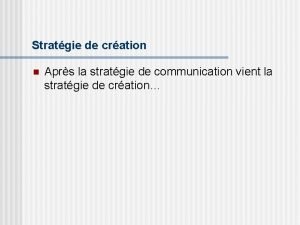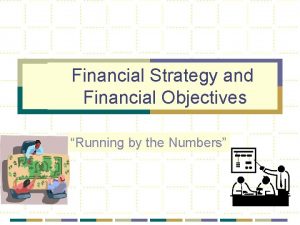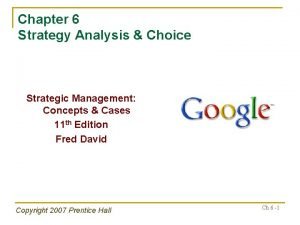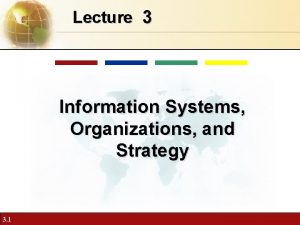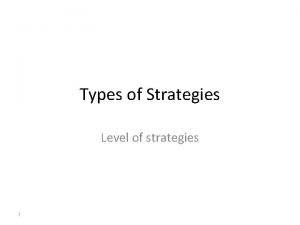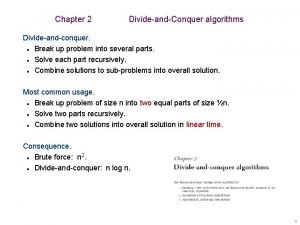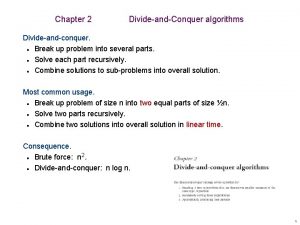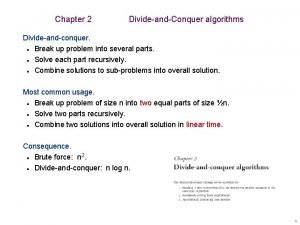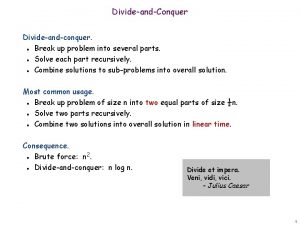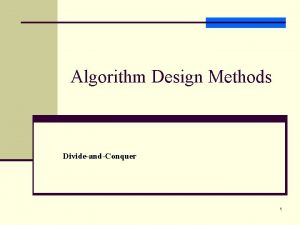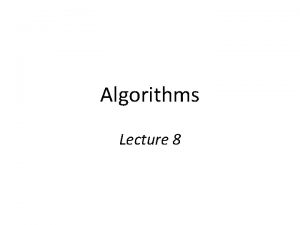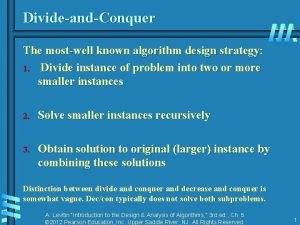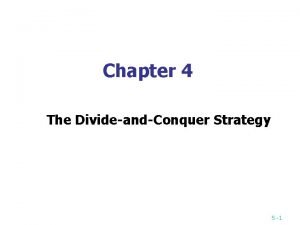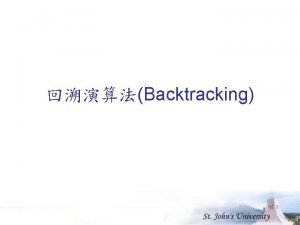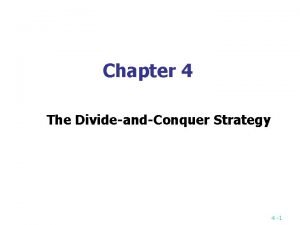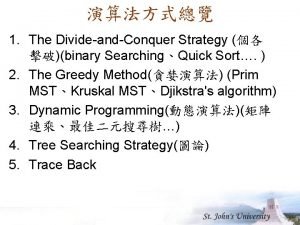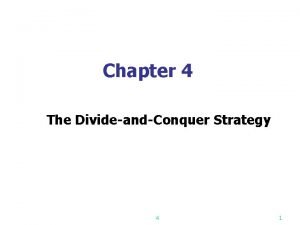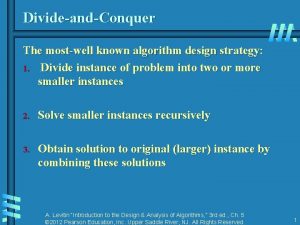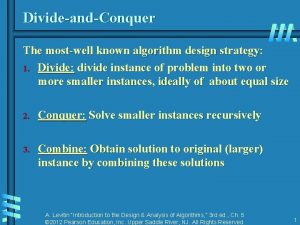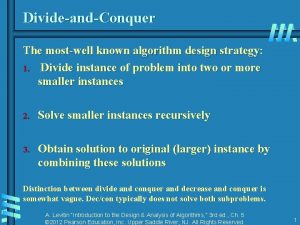The DivideandConquer Strategy 1 The DivideandConquer Strategy n







































































- Slides: 71

The Divide-and-Conquer Strategy (個各擊破)

演算法方式總覽 1. The Divide-and-Conquer Strategy (個各擊 破) n binary Searching、Quick Sort…. 2. The Greedy Method(貪婪演算法) n Prim MST、Kruskal MST、Djikstra's algorithm 3. Dynamic Programming(動態演算法) n 二項是係數、矩陣連乘、最佳二元搜尋樹… 4. Trace Back(回溯) n 圖形著色、漢米爾迴路問題…. 5. Tree Searching Strategy(樹的追蹤)





階乘 求n!,一般可能用的規則: n! = n * (n-1)!; 利用迴圈: ans = 1; for (i = 2; i <= n; i++) ans = ans * i; 利用遞迴: int fact(int n) { int x, y; if (n == 0) // boundary condition return(1); x = n-1; y = fact(x); return(n*y); } /* end fact */

遞迴呼叫流程圖 int fact(int n) { int x, y; if (n == 0) // boundary condition return(1); x = n-1; y = fact(x); return(n*y); } /* end fact */ n=4 fact(4) n=3 … y=fact(3 ) Fact(4)=24 fact(3) n=2 … Fact(3)=6 y=fact(2 ) fact(2) n=1 … Fact(2)=2 y=fact(1) n=0 … … Fact(1)=1 y=fact(0 ) fact(0) Fact(0)=1 Return(1)

遞迴呼叫流程圖 n 練習:fact(5)的呼叫過程,遞迴呼叫流程圖為 何。 n=5 int fact(int n) { int x, y; if (n == 0) // boundary condition return(1); x = n-1; y = fact(x); return(n*y); } /* end fact */

遞迴推疊圖 (The recursive stack) 呼叫過程: f 4 f 3 f 2 f 1 f 0 10

(i)printf(“%d”, fact(3)) n x y The stack at various times during execution. (An asterisk indicates an uninitialized value. ) 11


費氏數列 n 費氏數列 (Fibonacci number): f(0) = 0; * f(1) = 1; f(2) = f(1) + f(0); f(3) = f(2) + f(1); : f(n) = f(n-1) + f(n-2); n 利用遞迴範例: int fib(int n) { int x, y; if (n <= 1) return(n); x = fib(n-1); y = fib(n-2); return(x+y); } /* end fib */

遞迴呼叫流程圖 fib(4) … x=fib(3) n=3 fib(3)=2 … x=fib(2) n=1 fact(2) fib(3) n=2 … fib(1)=1 n=0 fib(2)=1 n=1 fact(2) n=2 y=fib(2) … fib(0) Return(0) fib(1)=1 n=1 fib(1)=1 n=0 y=fact(0) fib(4)=3 fib(0)=0 Return(1) fib(1) Return(1) x=fib(1) fib(2)=1 Return(1) x=fib(1) y=fact(0) y=fib(1) fib(0)=0 fib(0) Return(0) n=4 int fib(int n) { int x, y; if (n <= 1) return(n); x = fib(n-1); y = fib(n-2); return(x+y); } /* end fib */

遞迴推疊圖 (The recursive stack) 呼叫過程: f 4 f 3 f 2 f 1 15 f 2 f 1 f 0


遞迴推疊圖 f 5 呼叫過程: f 4 f 3 f 2 f 1 17 f 2 f 1 f 0 f 1 f 2 f 0 f 1 f 0






A general divide-and-conquer algorithm Step 1: If the problem size is small, solve this problem directly; otherwise, split the original problem into 2 sub-problems with equal sizes. Step 2: Recursively solve these 2 sub-problems by applying this algorithm. Step 3: Merge the solutions of the 2 subproblems into a solution of the original problem.






29






35


37



40





樞紐(pivot)







練習 1. finding the maximum of a set S of n numbers 2. 給下列陣列S,請用各個擊破演算法設計找 出最大的數 S 29, 14, 15, 1, 6, 10, 32, 12



Time complexity n Time complexity: n Calculation of T(n): Assume n = 2 k, T(n) = 2 T(n/2)+1 = 2(2 T(n/4)+1)+1 = 4 T(n/4)+2+1 : =2 k-1 T(2)+2 k-2+…+4+2+1 =2 k-1 = n-1



Strassen矩陣相乘設計 58




Example

Example

Strassen 演算法




68



 Tia chieu sa te
Tia chieu sa te Alleluia hat len nguoi oi
Alleluia hat len nguoi oi Một số thể thơ truyền thống
Một số thể thơ truyền thống Sơ đồ cơ thể người
Sơ đồ cơ thể người Tư thế ngồi viết
Tư thế ngồi viết Cong thức tính động năng
Cong thức tính động năng Số nguyên là gì
Số nguyên là gì đặc điểm cơ thể của người tối cổ
đặc điểm cơ thể của người tối cổ Tỉ lệ cơ thể trẻ em
Tỉ lệ cơ thể trẻ em Các châu lục và đại dương trên thế giới
Các châu lục và đại dương trên thế giới độ dài liên kết
độ dài liên kết ưu thế lai là gì
ưu thế lai là gì Môn thể thao bắt đầu bằng chữ f
Môn thể thao bắt đầu bằng chữ f Thẻ vin
Thẻ vin Hát kết hợp bộ gõ cơ thể
Hát kết hợp bộ gõ cơ thể Bàn tay mà dây bẩn
Bàn tay mà dây bẩn Từ ngữ thể hiện lòng nhân hậu
Từ ngữ thể hiện lòng nhân hậu Trời xanh đây là của chúng ta thể thơ
Trời xanh đây là của chúng ta thể thơ Tư thế ngồi viết
Tư thế ngồi viết Thế nào là giọng cùng tên?
Thế nào là giọng cùng tên? Voi kéo gỗ như thế nào
Voi kéo gỗ như thế nào Thơ thất ngôn tứ tuyệt đường luật
Thơ thất ngôn tứ tuyệt đường luật Khi nào hổ mẹ dạy hổ con săn mồi
Khi nào hổ mẹ dạy hổ con săn mồi Thế nào là hệ số cao nhất
Thế nào là hệ số cao nhất Diễn thế sinh thái là
Diễn thế sinh thái là đại từ thay thế
đại từ thay thế Ng-html
Ng-html Vẽ hình chiếu vuông góc của vật thể sau
Vẽ hình chiếu vuông góc của vật thể sau Thế nào là mạng điện lắp đặt kiểu nổi
Thế nào là mạng điện lắp đặt kiểu nổi Cách giải mật thư tọa độ
Cách giải mật thư tọa độ Lời thề hippocrates
Lời thề hippocrates Vẽ hình chiếu đứng bằng cạnh của vật thể
Vẽ hình chiếu đứng bằng cạnh của vật thể Tư thế worm breton là gì
Tư thế worm breton là gì Quá trình desamine hóa có thể tạo ra
Quá trình desamine hóa có thể tạo ra Sự nuôi và dạy con của hổ
Sự nuôi và dạy con của hổ điện thế nghỉ
điện thế nghỉ Các châu lục và đại dương trên thế giới
Các châu lục và đại dương trên thế giới Các loại đột biến cấu trúc nhiễm sắc thể
Các loại đột biến cấu trúc nhiễm sắc thể Biện pháp chống mỏi cơ
Biện pháp chống mỏi cơ Bổ thể
Bổ thể Thiếu nhi thế giới liên hoan
Thiếu nhi thế giới liên hoan Làm thế nào để 102-1=99
Làm thế nào để 102-1=99 Strategy formation
Strategy formation Firms that emphasize global integration make and sell
Firms that emphasize global integration make and sell Aligning hr strategy with business strategy
Aligning hr strategy with business strategy Listening strategies
Listening strategies Level strategy aggregate planning example
Level strategy aggregate planning example Transnational strategy vs global strategy
Transnational strategy vs global strategy Concentric growth strategy
Concentric growth strategy The strategy making strategy executing process
The strategy making strategy executing process International or multinational
International or multinational International strategy example
International strategy example Corporate strategy and business strategy
Corporate strategy and business strategy Copy strategy exemple
Copy strategy exemple Financial strategy objectives
Financial strategy objectives What is global strategy example
What is global strategy example Cyber security strategy austin
Cyber security strategy austin Strategic management chapter 6
Strategic management chapter 6 Chapter 7 customer driven marketing strategy
Chapter 7 customer driven marketing strategy Blue water strategy
Blue water strategy Information systems, organizations, and strategy
Information systems, organizations, and strategy Asos social media strategy
Asos social media strategy Bryson strategy change cycle
Bryson strategy change cycle Differentiation strategy
Differentiation strategy Heuristic test strategy model
Heuristic test strategy model Creative strategy planning and development
Creative strategy planning and development Global competitive strategy
Global competitive strategy Define corporate level strategy
Define corporate level strategy Netflix market development strategy
Netflix market development strategy Framing strategy examples
Framing strategy examples Strategy as a perspective
Strategy as a perspective Csr communication strategy
Csr communication strategy





















































